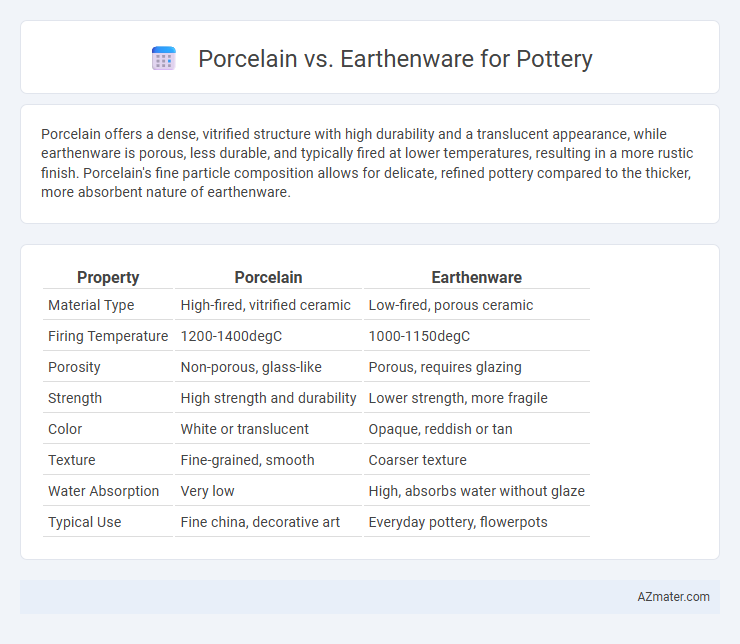Porcelain offers a dense, vitrified structure with high durability and a translucent appearance, while earthenware is porous, less durable, and typically fired at lower temperatures, resulting in a more rustic finish. Porcelain's fine particle composition allows for delicate, refined pottery compared to the thicker, more absorbent nature of earthenware.
Table of Comparison
| Property | Porcelain | Earthenware |
|---|---|---|
| Material Type | High-fired, vitrified ceramic | Low-fired, porous ceramic |
| Firing Temperature | 1200-1400degC | 1000-1150degC |
| Porosity | Non-porous, glass-like | Porous, requires glazing |
| Strength | High strength and durability | Lower strength, more fragile |
| Color | White or translucent | Opaque, reddish or tan |
| Texture | Fine-grained, smooth | Coarser texture |
| Water Absorption | Very low | High, absorbs water without glaze |
| Typical Use | Fine china, decorative art | Everyday pottery, flowerpots |
Introduction to Porcelain and Earthenware
Porcelain is a high-fired, vitrified ceramic known for its strength, translucency, and smooth, white surface formed from refined kaolin clay and fired at temperatures above 1,200degC. Earthenware, by contrast, is a porous, low-fired pottery typically ranging from 1,000degC to 1,150degC, made from naturally occurring clays with mineral impurities that result in a more rustic, opaque finish. While porcelain boasts durability and a delicate appearance suitable for fine tableware, earthenware is valued for its versatility and warmth in decorative and functional ceramics.
Composition and Materials Used
Porcelain is crafted from a refined blend of kaolin clay, feldspar, and quartz, resulting in a dense, white, and translucent ceramic that vitrifies at high temperatures. Earthenware contains more porous, coarse clays mixed with natural minerals like iron oxide, which fire at lower temperatures creating a more porous and opaque finish. The key difference in composition impacts durability, with porcelain offering greater strength and chip resistance compared to the softer, more porous earthenware.
Firing Temperatures and Processes
Porcelain is fired at extremely high temperatures ranging from 1,200degC to 1,450degC, resulting in a dense, vitrified, and translucent body that is both strong and durable. Earthenware, on the other hand, is typically fired at lower temperatures between 1,000degC and 1,150degC, producing a porous and less vitrified material that often requires glazing to achieve water resistance. The firing process for porcelain demands precise temperature control and longer firing cycles to achieve its signature hardness, while earthenware's lower temperature firing is more energy-efficient but results in a more porous final product.
Durability and Strength Comparison
Porcelain exhibits superior durability and strength due to its high firing temperature and vitrified, non-porous composition, making it resistant to chipping and cracking. Earthenware, fired at lower temperatures, remains more porous and fragile, resulting in a softer, less durable material prone to damage under stress. The dense structure of porcelain ensures enhanced longevity compared to the porous and more brittle characteristics of earthenware.
Texture and Appearance Differences
Porcelain features a smooth, glass-like texture with a translucent, white appearance that highlights fine details and a polished finish. Earthenware has a coarser, more porous texture with a matte, rustic surface that ranges in color from reddish-brown to buff. The visual contrast between the refined, delicate look of porcelain and the natural, earthy aesthetic of earthenware defines their distinct appeal in pottery.
Water Absorption and Porosity
Porcelain exhibits lower water absorption rates, typically less than 0.5%, due to its fine-grained, vitrified structure that significantly reduces porosity. Earthenware, being more porous with water absorption values around 6-15%, allows more moisture penetration, making it less suitable for holding liquids without glazing. The difference in porosity directly influences the durability and functional applications of each ceramic type in pottery.
Artistic Applications and Uses
Porcelain offers a smooth, translucent finish ideal for fine, detailed artistic pottery and intricate glazing techniques, making it a preferred choice for elegant sculptures and delicate decorative pieces. Earthenware, being more porous and rustic, excels in creating robust, textured works often used for functional pottery like planters, cookware, and folk art with traditional aesthetics. Artists value porcelain for precision and refinement, while earthenware is favored for its earthy appeal and versatility in larger, more practical ceramic items.
Cost and Accessibility
Porcelain typically costs more due to its refined materials and higher firing temperatures, making it less accessible for beginners and hobbyists. Earthenware is more affordable and widely available, with lower firing requirements that suit amateur potters and educational settings. The cost difference stems from porcelain's durability and translucency, while earthenware offers budget-friendly options suitable for practical and decorative pottery.
Environmental Impact and Sustainability
Porcelain production consumes higher energy due to its firing at temperatures above 1,200degC, resulting in a larger carbon footprint compared to earthenware, which fires at lower temperatures around 1,000degC. Earthenware's use of locally sourced clays often reduces transportation emissions, enhancing its sustainability profile. Both materials can be eco-friendly when sourced responsibly, but earthenware's lower energy demands and natural materials generally offer a smaller environmental impact.
Choosing the Right Clay for Your Pottery Projects
Porcelain offers a smooth, fine-grained texture and high durability, making it ideal for delicate, detailed pottery with a translucent finish. Earthenware, with its porous and softer composition, is easier to shape and fires at lower temperatures, perfect for beginners and rustic, decorative pieces. Selecting the right clay depends on your project's desired strength, finish, and firing temperature requirements.

Infographic: Porcelain vs Earthenware for Pottery
 azmater.com
azmater.com